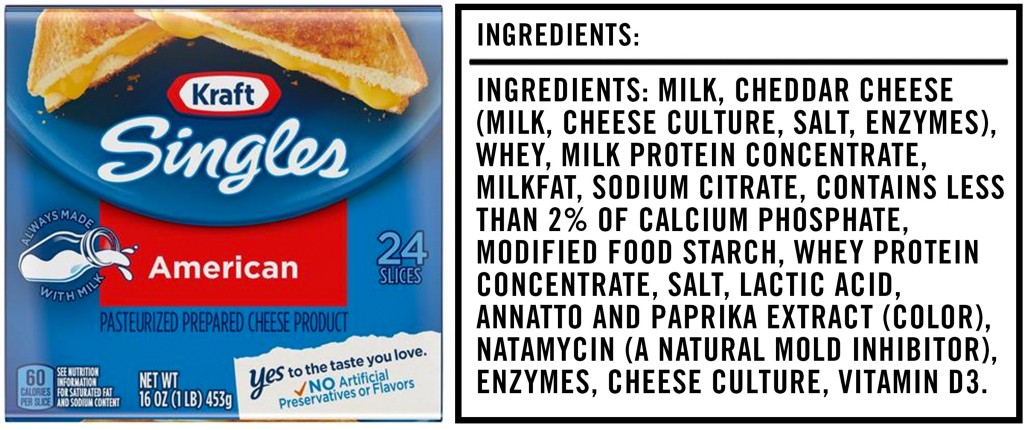Technically Walter Gerber and Fritz Stettler invented the first processed cheese in Switzerland in 1911 by heating cheese up and mixing in sodium citrate. Kraft patented the process in the USA in 1916. The term “American Cheese” was later coined to refer to any processed cheese.
The American Cheese Wikipedia page is poorly written with mostly redundant information from other Wikipedia pages… it’s just a commonly used word to refer to processed cheese and marketing term.
Again, that’s American cheese “food product”. That’s not American cheese.
… there’s no such thing as American cheese, then. American cheese is cheddar, Colby jack, and whatever else mild flavored cheese you want, melted in milk, and then reconstituted with sodium citrate. It’s “suspended cheese sauce”.
What are you talking about? Cheese made in America?
Can you provide an example? I checked online stores and everything labeled American cheese was processed cheese.
You’re getting mixed up between the requirements for “American Cheese” and “American Cheese Food,” which are distinct.
“Pasteurized Process American Cheese” is a cheese that follows a government regulatory definition, where the inputs are mostly cheddar and Colby cheese, and the milkfat requirements make it a little more difficult to try to make it with too much non-cheese ingredients.
Kraft Singles are the less strict “Process American Cheese Food” which only has to be 51% cheese by weight. But the labeling makes clear that it’s not just cheese. Kraft Deli Deluxe slices are labeled with the stricter definition of “Process American Cheese,” and pretty much any brand will have to stick with the label requirements.
There’s so much inaccurate in this, I don’t even know where to start. I’ll try and find the comment I made the last time this all came up, and either link or copy it here, but it was months ago, so I have no clue if I’ll find it.
The short version is that “American cheese” is cheese, just processed with an emulsifier to make it more stable and melt easier.
The process wasn’t german in origin, it was swiss, and even that isn’t fully accurate since the process used to make the original processed cheese in the US was slightly different.
And, if you read your packages in the US, where the terminology on packaging is legally defined and limited for cheese, you can tell whether or not it has any cheese in it by the terms used.
That’s the short version, and unless I find my previous mini essay, that’s all the work I’m willing to do this time around, but all of this is verifiable online if anyone wants to write up their own essay on the subject
Edit: holy shit, I actually found it quick! https://sh.itjust.works/comment/8390398
The swiss are just mountain germans.
I can’t deny this :)
holy shit, I actually found it quick!

Missing a bit of info: the extra processing is just grinding up the cheese and adding that emulsifier.
deleted by creator
Isn’t it a very low percent? We use 5% of the cheese’s weight in sodium citrate to make the cheddar sauce for our cheesy, beefy burritos at home.
Unless you mean the milk (or whatever substitute) it’s emulsified in?
(We were able to cut down on the milk and get a much stronger cheddar flavor compared to the previous cheese, milk, and corn starch version we used, but we still use 60% of the cheese’s weight in milk which does of course still dilute it a bit.)
Considering the minimum for calling it American cheese is 51% cheese, and we end up around 60% cheese, I don’t think the concentration is too low. You could just use cheddar on it’s own, but I think for both burgers and burritos the emulsified version is worth the milk dilution. Especially with the cheese sauce being nicely heated and spiced up with chili and a few other things.
I used to think American cheese was ridiculous, too, before I watched an Adam Ragusea video about why sauces break, wherein he had a part about cheese sauces, and demonstrated the “natural” way to get the emulsifying salt from lemon juice by heating it mixed with baking soda and tasting until it’s no longer tart… I think it was?
Either way we tried a few times, it was difficult, but then I just bought a small container of sodium citrate to skip that step. Immediately changed my mind about emulsifiers after trying it. It was just nice. A really silky, awesome sauce.
This person cooks.
Not really, no.
When the original swiss guys were working on their version, they were explicitly seeking to extend the length the cheese would remain edible.
When Kraft came up with his version, the same goal was in place. He wanted to be able to ship his products farther.
If anything, his use of trimmings was a side-effect that made it cheaper originally, not the other way around. He used excess cheese during his attempts, which was a cheap supply. But the emulsifier itself doesn’t do anything to make it cheaper. I’d even debate that the heating process that halts the breakdown of cheese made it much cheaper by itself, but rather as an offshoot by reducing wastage.
All of this is pretty well documented, and not just by the Kraft company. There’s records of the Swiss guys, their process, and communications. They were explicitly working based off of fondue, and how it lasts. The shelf stability of it comes from the the heat used to process the cheese, same with fondues. That’s why they worked with chemicals that would interact with the calcium that lets casein hold the milk fats together; the old school fondue was done with tartaric acid (which is a byproduct of wine making, iirc). They ended up using sodium citrate.
I mean, unless you’ve seen documentation I haven’t? I cobbled all this together from online sources, which means translations of the swiss stuff, and mostly excerpts in that regard. The Kraft stuff is in English, and they used to have their records online, and there were copies of that used in news articles and such over the years since a lot of publications moved online. But I definitely never saw/handled the original documents, and I don’t doubt that there are plenty that weren’t online when I first looked into things years ago (the comment I linked was a mini version of a project I did for a class, based on stuff I picked up from family that run a dairy).
Edit: here’s a link to Kraft’s patent from 1916 for his pasteurization process https://patentimages.storage.googleapis.com/a8/45/8a/3471c3db9f16a3/US1186524.pdf
The hamburger did not originate in Germany, despite its name. While the exact origins are debated, it is pretty well agreed that it was created in the US sometimes in the late 19th to early 20th century.
The closest connection to germany that some try to make is an entirely different dish that uses ground beef or pork, which is such a loose connection that you might as well say it originated in Egypt as they were the first civilization to make bread.
The problem is that the origin is “hamburger
beefsteak” which is the beef patty that came from Germany. This was combined with a sandwich to create a “hamburger sandwich”. Over time, the sandwich part was dropped and now here we are.It wasn’t even really a patty as we know it in burgers, it was more like a slice of breakfast sausage.
I’d argue if you put breakfast sausage on a bun it adequately fits the definition of a burger.
I guess that’s true. It’s more the distinction of the paddy being formed by hand or being sliced out of a big roll of sausage.
And sausage is a completely different thing than ground beef formed into a patty.
There’s pork burgers, sausage is just ground meat (generally pork) that’s been seasoned and sometimes encased/preserved.
You happened to ask this while I was in a smaller class at my college so I was able to start a “civil discussion” over whether a Sausage McMuffin was a burger.
I wouldn’t call a slice of sausage a patty, so I disagree
I cannot tell you why, though, and I make my own sausages and burgers by hand so like, I should know why?
Yeah, that’s a breakfast sandwich. Why? Idk.
No, that’s a mcmuffin, or a breakfast sandwich.
I mean if you wanna get technical a burger is just ground meat between two halves of a bun. Therefore one could argue a McMuffin is also a burger
Nope.
A burger is ground beef patties between two halves of a bun. Any other meat is a sandwich. The reason is that “burger” is short for “hamburger,” which is the term we use for ground beef, so by definition, a burger is beef.
Veggie burgers are in a weird place, because they should be sandwiches, but since they’re intended to be a drop-in veggie substitute, we call them burgers. But they’re always prefixed with a qualifier, like “veggie burger” or “bean burger.”
A hamburger, or simply a burger, is a dish consisting of fillings—usually a patty of ground meat, typically beef—placed inside a sliced bun or bread roll.
Note that “typically” and “always” are of different meanings. I’ve made sliders with ground pork before, what is a slider if not a small burger?
A burger is a sandwich with a patty made of ground meat. That meat can be beef, pork, turkey, hell, even chicken if that’s your sort of thing. And, like you said, veggies.
No, the “hamburger steak”, mentioned in the Oxford dictionary in 1802, was roasted and salted minced beef meat. So pretty close to the present day patty actually.
The story I heard was that it came to America with Russian Jewish immigrants who took transatlantic ocean liners from Hamburg, which is where it got its name from. (The Jewish origins are important as apparently the beef patty we know originated as a way of prepreparing kosher meals for travelling through areas where options were unknown.)
The wider world when they think of American cheese: yellow shiny shrink wrapped oily substance, wiggles like rubber
Me thinking of the American cheese I’ve eaten all of my life: white, dry-ish, cut from actual blocks at the deli, feels like, well, cheese

Dunno if it’s some regional thing or what. The only place I see yellow American is at chain restaurants.
Also, related and timely:
Where I’m from, we have access to sharp american cheese. It slaps.
Pointing to kraft singles and insisting that “american cheese bad” is like pointing to Little Caesars and insisting that pizza is a lousy food.
Little Caesars is pretty darn good, considering it’s 1/3 the cost of any other chain.
My point being that if someone didn’t like little caesars and concluded that pizza is bad, that opinion is terribly uninformed
Oh, sorry, didn’t mean to confuse things. Your point was clear!
Lots of people only think of Kraft singles when they hear American cheese. Nothing beats a burger/grilled cheese with real deli style American cheese
I believe, “American cheese” is just the name of the orange stuff: https://en.wikipedia.org/wiki/American_cheese
No, American cheese, the real cheese, comes in white and orange.
Orange has food coloring added. Like some other cheeses.
The kraft stuff is “American Cheese Food Product”, says so right on the label.
It can be any color from white to orange, it’s Colby jack mixed with cheddar and emulsifiers
More Colby (white cheese) results in a lighter color, more or sharper cheddar will give you more yellow/orange
People seem to forget there’s a difference between American cheese and fucking Kraft singles. Kraft singles are like the Spam “ham” of cheeses.
They don’t forget, they conveniently ignore the label on kraft singles that says “Cheese Product”.
That’s not American cheese.
That’s the kraft “cheese food product”.
American cheese is essentially Swiss that hasn’t aged.

Edit: looks like they’ve changed the label, but it still says “cheese product”, so NOT cheese, kraft even admits it.
Swiss that hasn’t aged
But “Swiss cheese” isn’t a thing in itself either. The term is used solely in the US.
Switzerland has all kinds of very different kinds of cheese. Aged and young ones.
Kraft is obligated by food regulations. They can not call a product “cheese” if it is not a certain percentage cheese.
It also makes a really good grilled cheese
Yea, people try to get fancy with regular cheese on grilled cheese sandwiches and I hate it. Every one I’ve tried as soon as it cools off it gets weird and lumpy and gross. Kraft singles stay melty a lot better. Also great on egg sandwiches for the same reason. I do prefer regular cheeses on burgers though.
You didn’t ask, but I’ll tell you how I make a grilled cheese with normal cheese. I have never experienced “lumpy and gross”, but perhaps this is left to the individual.
Choose your bread. Anything you desire. Choose your cheeses. Nothing wrong with mixing it up and using different cheeses. If you have one of the cheese platters in the house that has a variety, this is the prime time to make a grilled cheese. Butter the pan and lay down your first slice of bread (medium-low heat). Lay whatever cheese you like on the inner side of the bread (season if desired). Let the bread toast and the cheese will soften, but you can cover it to let the heat build up enough. Not too long though as you don’t want moisture building up. Throw your second slice of bread on top when you want and when the bottom side meets your expectations of toasty, flip the sandwich (during the flip, I flick more butter in for the fresh breaded side to begin its toasting session). You are now faced with the toasted side. Take more cheese and place it on the toasted side. I often use parmesan or asiago (you can use any type), but do not use a lot here. When the second side is toasted to suit, flip it back on to the outer cheese side so it can melt and toast again. Then ply the second toasted side with cheese and flip when the time is right. You will have a nicely toasted cheesy side now with the second toasted cheesy side.
You can season with garlic or garlic salt or some other herb or spice you enjoy. I love making grilled cheese sandwiches like this. They seem fancier and definitely have more flavor. I also welcome any constructive criticism or suggestions to help “up” my game further as I am always looking to improve.
You can use fancier cheeses in a GC too, but you still need at least one slice of fake cheese for proper consistency. It’s the immulsifiers.
I have not tried mixing them… I’ll give that a shot.
That’s why you eat them hot. I never use “American cheese” of any variety in a grilled cheese, I almost always use cheddar, and occasionally throw in some form of jack (Monterey Jack, PepperJack, etc). The trick is to cook it on medium-low heat and cover with a lid so it thoroughly warms the sandwich, if you cook it too hot w/ the lid off, the cheese doesn’t heat enough to properly melt.
There’s a pretty small window between not burning yourself and it cooling to the point the texture gets weird. I don’t like having to eat that fast.
Idk, they stay reasonably warm for like 15 minutes for me, which is plenty of time to enjoy eating it.
I will not sit here and let grilled cheese be forgotten. American is the best at any melty cheese sandwhich!
Common mistake. American Cheese is cheese. It’s a blend, just like Colby Jack, and nobody argues that’s not cheese.
Kraft Singles are not cheese. That’s different.
American cheese is the best cheese for a cheeseburger because it melts without splitting
- Chef Voldemort
Cheddar is the worst, it’s too oily.
American cheese (real American, not that kraft garbage) is the best.
Other similar cheeses, like Swiss, are also good.
Cheddar is best for some other things.
Cheddar rocks for burgers, but you do need to offset the oiliness a bit, which is what the other toppings are for (mustard, ketchup, lettuce, tomato, etc). That said, I like jack cheeses way more, especially pepperjack. That spice works really well with the savory beef.
I’m not saying American cheese is good, but sometimes you just need that shit on a breakfast sandwich.
As an American, American “cheese” (including single slices, and things like spray cheese) fucking suck. Give me a good pepperjack or white cheddar on my burger, not that processed shit.
I like the goo in a can on Ritz or Wheat Thins.
But I have no illusion about what I’m eating.
That kraft garbage is not allowed in my house.
Spray cheese, Ritz, topped with a pizza roll. It was one of my “treating myself” staples in college
Oh man, with a pizza roll? Now you’re livin’!
Yup, I don’t buy those singles or anything adjacent to them, but I do like a variety of American cheeses. Jack cheeses like Pepper Jack are absolutely American and work really well on burgers and grilled cheese sandwiches.
It’s full of emulsifiers and nearly flavorless so it can also make sauces super creamy
You can add sodium citrate and milk to just about any cheese to make it melt smoother if you want. Skip adding American entirely.
I can find american cheese a lot easier than I can find sodium citrate
True. But now you have options.

Aren’t you just describing more or less how they actually make American cheese? Real cheese (cheddar and ?) mixed with curd and emulsifiers.
Pretty much. Just pointing out that you don’t need to cut your sauce with American to make it gooey.
American is so mild that an even somewhat flavorful cheese will overpower the hell out of it. I’m not worried about a single slice of american diluting my cheese sauce. Not to any perceptible degree, anyway.
Again, that would be “American Cheese Food Product” which is right on the Kraft label.
And that shit never crosses my threshold.
It’s Velveeta, versus cheddar. Our Velveeta melts much better.
IMO the ideal thing to do for hamburgers, mac and cheese, and grilled cheeses (the three foods that I would consider using American cheese for) is this:
Half american cheese for meltiness, half gruyere or other aged flavorful cheese for flavor.
A lot of modern recipes suggest that approach and it has worked well for me.
Pfft, you don’t need American cheese to get a proper melt, you just need a bit of patience and timing. If you really want an easy melt, throw on a jack cheese, like Monterey Jack or Pepper Jack. But if you cover your grilled cheese or burger, even a harder cheddar will melt well, you just need to eat it while it’s hot.
For mac and cheese, you just need to thin out the cheese with some half and half (or milk if you’re hard up). Make a roux, then add your milk and cheese, then mix in your noodles. The consistency doesn’t come from the meltiness of the cheese, but the milk/cream you add to the roux.












